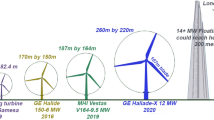Abstract
The significant integration of intermittent generation resources such as wind power in a system dictates the need to utilize a systematic approach such as the effective load carrying capability (ELCC) method to assess the capacity value of the intermittent resources and to ensure that the generation resource adequacy and sufficient long-term generation reserves are maintained. Pertinent factors that can influence the ELCC outcomes should therefore be recognized and understood prior to placing substantial reliance on its utilization for long-term planning purposes. This paper investigates key factors that affect the predicted ELCC such as the system generating capacity composition, load pattern, generating unit parameters, desired system reliability level, system size, wind conditions at a site and the wind penetration level as well as its wind speed correlation. Both conventional generation and wind power generation are used to illustrate the ELCC effects under different system conditions.










Similar content being viewed by others
References
BC Hydro Website—Wind Monitoring. Available online at: http://www.bchydro.com/planning_regulatory/energy_technologies/wind_energy/wind_monitoring.html
Billinton R, Allan RN (1996) Reliability evaluation of power systems, 2nd edn. Plenum Press, New York
Billinton R, Chen H (1998) Assessment of risk-based capacity benefit factors associated with wind energy conversion systems. IEEE Trans Power Syst 13(3):1191–1196
Billinton R, Gao Y (2008) Multistate wind energy conversion system models for adequacy assessment of generating systems incorporating wind energy. IEEE Trans Energy Conver 23(1):163–170
Billinton R, Li W (1994) Reliability assessment of electrical power systems using Monte Carlo methods. Plenum Publishing, New York
Billinton R, Wangdee W (2005) Impact of utilizing sequential and non-sequential simulation techniques in bulk electric system reliability assessment. IEE Proc Generat Transm Distrib 152(5):623–628
Billinton R, Gao Y, Karki R (2009) Composite system adequacy assessment incorporating large-scale wind energy conversion systems considering wind speed correlation. IEEE Trans Power Syst 24(3):1375–1382
Gao Y, Billinton R (2009) Adequacy assessment of generating systems containing wind power considering wind speed correlation. IET Renew Power Generat 3(2):217–226
Garver LL (1966) Effective load carrying capability of generating units. IEEE Trans Power Apparatus Syst PAS-85(8):910–919
Karapidakis ES, Thalasinakis M (2006) Analysis of wind energy effects in Crete’s island power systems. The sixth world energy system conference, Torino, Italy, July 10–12, 2006
Li W (2007) MECORE program: user’s manual. British Columbia Transmission Corporation, Canada
Marti I et al (2004) Wind power prediction in complex terrain: from the synoptic scale to the local scale. The science of making torque from wind conference. Delft, The Netherlands, pp 19–21
Milligan M, Porter K (2008) Determining the capacity value of wind: an updated survey of methods and implementation. National Renewable Energy Laboratory (NREL), Golden, CO, June 2008. Available online at: http://www.nrel.gov/docs/fy08osti/43433.pdf
Peace River Site C Hydro Project: Pre-consultation discussion guide and feedback form. BC Hydro, December 2007. Available online at: http://www.llbc.leg.bc.ca/public/PubDocs/bcdocs/430786/policies54179.pdf
Special Report on “Accommodating High Levels of Variable Generation”, North American Reliability Corporation (NERC), April 2009. Available online at: http://www.nerc.com/files/IVGTF_Report_041609.pdf
Wangdee W, Billinton R (2006) Considering load carrying capability and wind speed correlation of WECS in generation adequacy assessment. IEEE Trans Energy Conver 21(3):734–741
Wangdee W, Li W, Shum W, Choudhury P (2009) Assessing transfer capability requirement for wind power generation using a combined deterministic and probabilistic approach. Proceedings of the 2009 IEEE power and energy society general meeting, Calgary, Canada, July 2009
Wind Integration Datasets. National Renewable Energy Laboratory (NREL). Available online at: http://www.nrel.gov/wind/integrationdatasets/western/methodology.html
Author information
Authors and Affiliations
Corresponding author
Rights and permissions
About this article
Cite this article
Wangdee, W., Li, W. & Billinton, R. Pertinent factors influencing an effective load carrying capability and its application to intermittent generation. Int J Syst Assur Eng Manag 1, 146–156 (2010). https://doi.org/10.1007/s13198-010-0025-6
Received:
Published:
Issue Date:
DOI: https://doi.org/10.1007/s13198-010-0025-6




